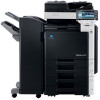Konica Minolta bizhub C280 Product Guide - Page 181
Vendors can complete a VPAT Voluntary Product Accessibility Template
 |
View all Konica Minolta bizhub C280 manuals
Add to My Manuals
Save this manual to your list of manuals |
Page 181 highlights
bizhub C360/C280/C220 Security SECTION 508 Section 508 is a part of the Rehabilitation Act of 1973 which requires that electronic and information technology developed, procured, maintained, or used by the Federal government be accessible to people with disabilities. Vendors can complete a VPAT (Voluntary Product Accessibility Template) that provides information on how a product or service conforms to the Section 508 Access Board Standards. Konica Minolta products' VPAT is posted on public website. Aside from the Section 508 compatibility described in the control panel, the bizhub C360/C280/C220 also meets other requirements. They include toner replacement, imaging unit replacement and paper replacement. Section 508 of the Rehabilitation Act Konica Minolta designs the products around Section 508 Check Point: Result of Evaluation by Monitors Pre-Designing Stage Product Designing Stage STEP 2 Design STEP 1 Hypothesis STEP 5 Accessibility Specifications FAIL PASS STEP 4 & 8 EVALUATION STEP 6 Product Design STEP 3 Create a Model STEP 7 Sample Machine If PASS, then go to Product Designing Stage If FAIL, go back and revise Hypothesis and start again 177















